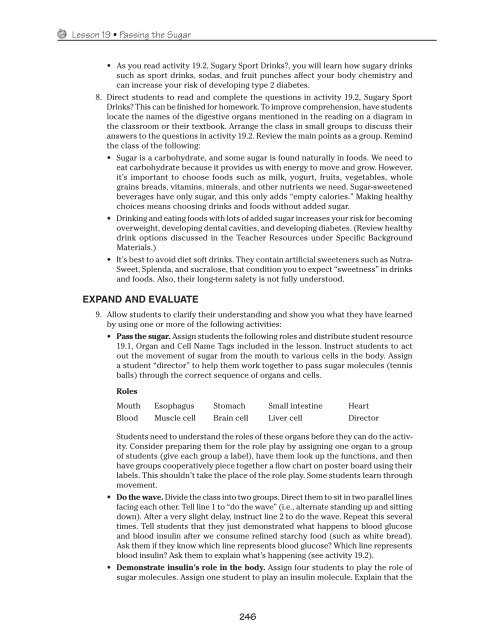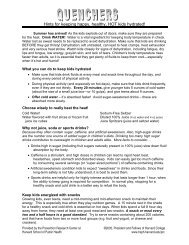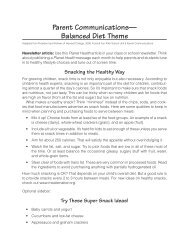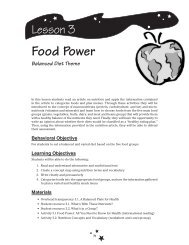Lesson 19: Passing the Sugar - Planet Health
Lesson 19: Passing the Sugar - Planet Health
Lesson 19: Passing the Sugar - Planet Health
You also want an ePaper? Increase the reach of your titles
YUMPU automatically turns print PDFs into web optimized ePapers that Google loves.
<strong>Lesson</strong> <strong>19</strong> • <strong>Passing</strong> <strong>the</strong> <strong>Sugar</strong>• As you read activity <strong>19</strong>.2, <strong>Sugar</strong>y Sport Drinks?, you will learn how sugary drinkssuch as sport drinks, sodas, and fruit punches affect your body chemistry andcan increase your risk of developing type 2 diabetes.8. Direct students to read and complete <strong>the</strong> questions in activity <strong>19</strong>.2, <strong>Sugar</strong>y SportDrinks? This can be finished for homework. To improve comprehension, have studentslocate <strong>the</strong> names of <strong>the</strong> digestive organs mentioned in <strong>the</strong> reading on a diagram in<strong>the</strong> classroom or <strong>the</strong>ir textbook. Arrange <strong>the</strong> class in small groups to discuss <strong>the</strong>iranswers to <strong>the</strong> questions in activity <strong>19</strong>.2. Review <strong>the</strong> main points as a group. Remind<strong>the</strong> class of <strong>the</strong> following:• <strong>Sugar</strong> is a carbohydrate, and some sugar is found naturally in foods. We need toeat carbohydrate because it provides us with energy to move and grow. However,it’s important to choose foods such as milk, yogurt, fruits, vegetables, wholegrains breads, vitamins, minerals, and o<strong>the</strong>r nutrients we need. <strong>Sugar</strong>-sweetenedbeverages have only sugar, and this only adds “empty calories.” Making healthychoices means choosing drinks and foods without added sugar.• Drinking and eating foods with lots of added sugar increases your risk for becomingoverweight, developing dental cavities, and developing diabetes. (Review healthydrink options discussed in <strong>the</strong> Teacher Resources under Specific BackgroundMaterials.)• It’s best to avoid diet soft drinks. They contain artificial sweeteners such as Nutra-Sweet, Splenda, and sucralose, that condition you to expect “sweetness” in drinksand foods. Also, <strong>the</strong>ir long-term safety is not fully understood.Expand and Evaluate9. Allow students to clarify <strong>the</strong>ir understanding and show you what <strong>the</strong>y have learnedby using one or more of <strong>the</strong> following activities:• Pass <strong>the</strong> sugar. Assign students <strong>the</strong> following roles and distribute student resource<strong>19</strong>.1, Organ and Cell Name Tags included in <strong>the</strong> lesson. Instruct students to actout <strong>the</strong> movement of sugar from <strong>the</strong> mouth to various cells in <strong>the</strong> body. Assigna student “director” to help <strong>the</strong>m work toge<strong>the</strong>r to pass sugar molecules (tennisballs) through <strong>the</strong> correct sequence of organs and cells.RolesMouth Esophagus Stomach Small intestine HeartBlood Muscle cell Brain cell Liver cell DirectorStudents need to understand <strong>the</strong> roles of <strong>the</strong>se organs before <strong>the</strong>y can do <strong>the</strong> activity.Consider preparing <strong>the</strong>m for <strong>the</strong> role play by assigning one organ to a groupof students (give each group a label), have <strong>the</strong>m look up <strong>the</strong> functions, and <strong>the</strong>nhave groups cooperatively piece toge<strong>the</strong>r a flow chart on poster board using <strong>the</strong>irlabels. This shouldn’t take <strong>the</strong> place of <strong>the</strong> role play. Some students learn throughmovement.• Do <strong>the</strong> wave. Divide <strong>the</strong> class into two groups. Direct <strong>the</strong>m to sit in two parallel linesfacing each o<strong>the</strong>r. Tell line 1 to “do <strong>the</strong> wave” (i.e., alternate standing up and sittingdown). After a very slight delay, instruct line 2 to do <strong>the</strong> wave. Repeat this severaltimes. Tell students that <strong>the</strong>y just demonstrated what happens to blood glucoseand blood insulin after we consume refined starchy food (such as white bread).Ask <strong>the</strong>m if <strong>the</strong>y know which line represents blood glucose? Which line representsblood insulin? Ask <strong>the</strong>m to explain what’s happening (see activity <strong>19</strong>.2).• Demonstrate insulin’s role in <strong>the</strong> body. Assign four students to play <strong>the</strong> role ofsugar molecules. Assign one student to play an insulin molecule. Explain that <strong>the</strong>246





